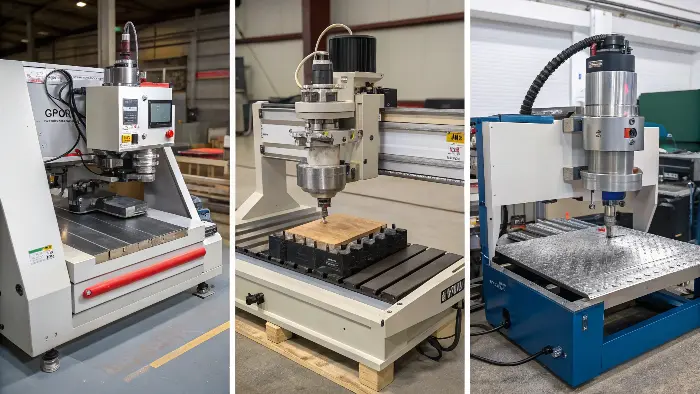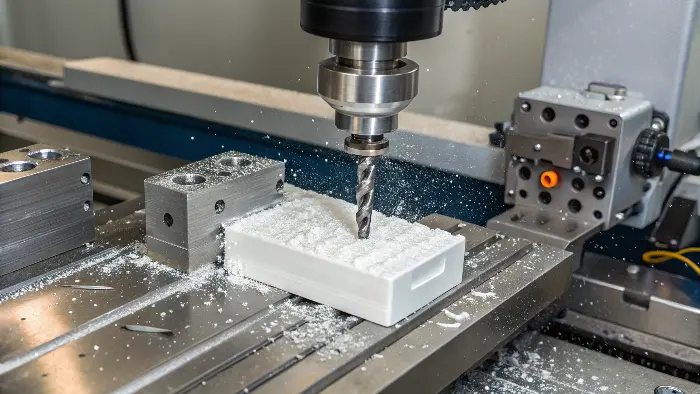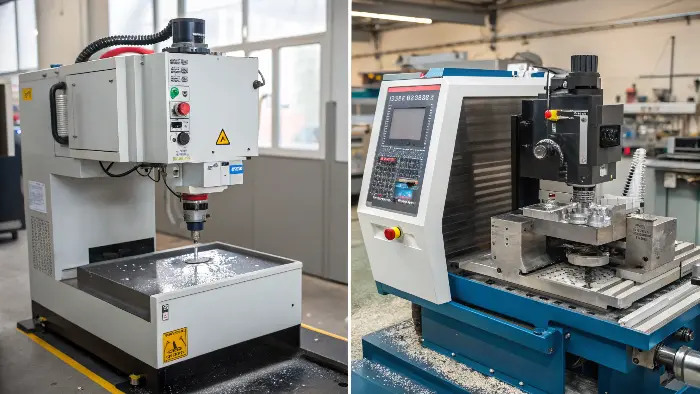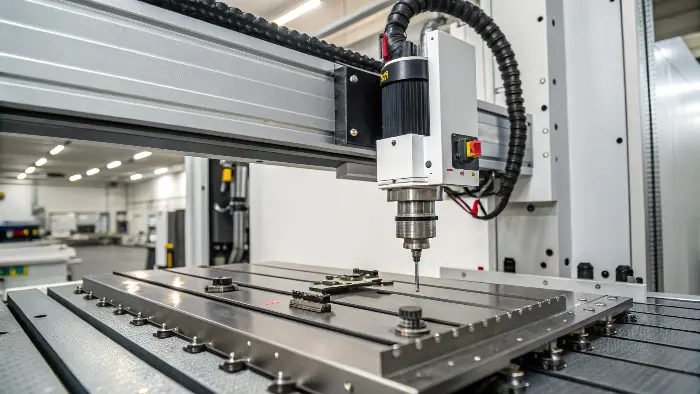Struggling to pick a CNC machine? Overwhelmed by options and unsure what fits your project? I can help you find the perfect match.
Choosing the right CNC machine means matching its capabilities to your specific manufacturing requirements. Consider material, part complexity, production volume, and desired precision. This ensures optimal performance, cost-effectiveness, and quality for your projects.

Selecting the ideal CNC machine can feel like a big task. There are many factors to think about. But don’t worry. I’ve been through this many times, helping clients like Alex, an engineer in Germany who needs high-tolerance parts. Let’s break down the key things you need to consider. This will help you make a smart choice and get the best results for your manufacturing.
What are the main types of CNC machines I should consider?
Confused by CNC mills, lathes, or routers? Unsure which type handles your specific parts best? I’ll clarify the common types for you.
The main types are CNC mills for complex shapes, CNC lathes for cylindrical parts, and CNC routers for softer materials or large sheets. Each is designed for different geometries and materials, so understanding them is key.

When I first started in a CNC shop, understanding the different machines was crucial. For engineers like Alex, who designs intricate robotic components, knowing the machine types is the first step. Let’s look closer.
-
CNC Milling Machines:
These are very versatile. They use rotating cutting tools to remove material from a workpiece. You can create complex shapes, slots, holes, and three-dimensional contours. Mills come in 3-axis, 4-axis, and 5-axis versions. More axes mean more complex geometries can be machined in a single setup. For many of the robotic arm parts Alex designs, a 5-axis mill is often essential to achieve the necessary features without multiple setups. This saves time and improves accuracy. I recall a project where a client was struggling with a part that had undercuts and angled features. Moving to a 5-axis machine simplified the process immensely and improved the part quality. -
CNC Lathes (Turning Centers):
Lathes are for parts that are cylindrical or round. The workpiece rotates while a cutting tool shapes it. Think of shafts, pins, or custom fittings. Modern CNC lathes, often called turning centers, can also have live tooling. This means they can perform some milling or drilling operations. This makes them even more useful for parts that are mostly round but have some other features. For instance, we often produce custom bolts with cross-drilled holes on our turning centers. -
CNC Routers:
Routers are typically used for softer materials like wood, plastic, or aluminum sheets. They are great for cutting large, flat parts, engraving, or creating detailed patterns. While they might not offer the same ultra-high precision as a high-end mill for steel, they are very efficient for their intended applications. We use them for making jigs and fixtures from plastic, or for large panel work. -
Other Specialized CNC Machines:
There are also CNC grinders for super-fine finishes, EDM (Electrical Discharge Machining) for very hard materials or complex internal shapes, and laser cutters. The choice depends entirely on what you need to make. For most metal parts that engineers like Alex design, mills and lathes are the workhorses.
Understanding these basic types helps you narrow down your options significantly.
How does the material I’m machining affect my CNC choice?
Working with tough metals or soft plastics? Unsure if your chosen machine can handle the material? Material properties are a big factor.
Material properties like hardness and machinability directly influence CNC machine choice. Harder materials need more robust, powerful machines with specific tooling. Softer materials might allow for faster speeds on less rigid machines.

I remember a project for a client who wanted to switch from aluminum to titanium for a component. The original machine setup, which was fine for aluminum, just wasn’t up to the task for titanium. The machine lacked the necessary rigidity and spindle torque. Material choice is critical. Alex often works with various grades of aluminum and stainless steel, so he needs machines that can handle both effectively.
Here’s how materials impact your decision:
-
Material Hardness and Strength:
Harder materials like stainless steel, titanium, or Inconel require machines with high spindle power, torque, and a very rigid structure. The cutting forces are much greater. Softer materials like aluminum, brass, or plastics can be machined on less powerful, sometimes faster, machines. For example, machining 316 stainless steel requires significantly lower cutting speeds and more robust tooling compared to 6061 aluminum. -
Machinability:
Some materials are easier to cut than others. For example, free-machining steel is designed to be cut easily, producing small chips. Other materials, like some stainless steels (e.g., 304), can be "gummy" or work-harden quickly if the cutting parameters aren’t right. This affects the choice of cutting tools, speeds, feeds, and even the coolant system on the CNC machine. -
Thermal Properties:
Materials expand and contract with temperature changes. Some materials are more sensitive than others. For high-precision parts, a machine with good thermal stability or compensation features might be necessary, especially if the material has a high coefficient of thermal expansion. The machine’s coolant system also plays a role here, helping to manage heat at the cutting zone and maintain dimensional stability. -
Abrasiveness:
Some materials, like composites with glass or carbon fibers, or even some high-silicon aluminums, are very abrasive. They can wear out cutting tools and even machine components quickly. Special tooling (like diamond-coated tools) and machine features (like hardened ways or better seals) might be needed to handle these.
Here’s a simple table to illustrate:
| Material Type | Key Considerations for CNC Machine | Example Machine Features Needed |
|---|---|---|
| Soft Metals (Alu) | High speed capability, good chip evacuation | High RPM spindle (10,000+ RPM), efficient coolant/air blast |
| Hard Metals (Steel) | Rigidity, high torque at low RPM, power | Box ways or heavy-duty linear guides, geared head or powerful spindle motor |
| Plastics | Lower cutting forces, potential for melting, chip control | Sharp tooling, appropriate speeds/feeds, sometimes air cooling, good chip extraction |
| Composites | Abrasiveness, dust control, delamination prevention | Diamond-coated tools, good enclosure, robust dust extraction system, sharp tools |
Thinking about the material first can save a lot of headaches and ensure you pick a machine that’s truly capable for your parts.
How do production volume and part complexity guide CNC machine selection?
Making one-off prototypes or thousands of parts? Are your designs simple or very intricate? Volume and complexity will steer your machine choice.
For low-volume or simple parts, a basic 3-axis machine might be fine. High-volume production or complex geometries often demand multi-axis machines, automation features like pallet changers, or specialized turning centers for efficiency.

Alex often needs small batches of highly complex prototypes for his robotics work. Later, some of these might go into larger production runs. The machine choice can differ significantly for these stages. I’ve seen companies try to make high-volume parts on a machine best suited for prototyping, and the costs just don’t work out.
Let’s break this down:
-
Production Volume:
- Prototypes and Low Volume: For one-offs or small batches (like 1-50 pieces), a standard 3-axis mill or a 2-axis lathe might be perfectly adequate. Setup time is a larger proportion of the total time, so ease of programming and setup can be important. You don’t necessarily need the fastest machine, but one that’s versatile and quick to change over.
- Medium Volume: For hundreds of parts, you might look for machines with faster cycle times. Perhaps a horizontal machining center (HMC) with an automatic pallet changer (APC) is a good choice. Or a lathe with a bar feeder. These features reduce manual intervention and keep the machine running more continuously, which lowers the per-part cost.
- High Volume: For thousands or tens of thousands of parts, dedicated machines, robotic loading/unloading, and highly optimized processes are key. Swiss-type lathes are excellent for high-volume small, complex turned parts. Transfer lines or custom automated cells might be considered for very large quantities to maximize throughput and minimize labor.
-
Part Complexity:
- Simple Parts: Parts with features mostly on one or two faces, or simple turned profiles, can be made on basic 3-axis mills or 2-axis lathes. Think of simple brackets or standard pins.
- Moderately Complex Parts: Parts with features on multiple sides might need a 4th-axis rotary table on a mill, or a lathe with live tooling and a Y-axis. This reduces the number of setups, which improves accuracy and reduces overall machining time.
- Highly Complex Parts: Components with sculpted surfaces, deep pockets, or angled holes on multiple faces (like many of Alex’s robotic joints) often require a 5-axis milling machine. This allows the tool to approach the workpiece from many different angles, enabling the creation of very intricate geometries in a single setup. This was a game-changer for one of my clients who was struggling with accuracy issues and long lead times due to multiple setups on a 3-axis machine for a complex aerospace part. Moving to 5-axis machining solved both problems.
The interplay between volume and complexity is crucial. A simple part at high volume might justify a very specialized, fast machine. A complex part at low volume needs a versatile machine like a 5-axis mill.
What impact do precision and tolerance requirements have on choosing a CNC machine?
Need parts with extremely tight tolerances? Worried about achieving the required accuracy? Precision needs dictate machine quality and features significantly.
Higher precision and tighter tolerances demand more robust, thermally stable CNC machines with high-quality components like linear scales, precision ball screws, and advanced control systems. These features ensure accuracy and repeatability.

Alex, the engineer I mentioned, regularly works with tolerances of ±0.01mm (0.0004 inches) or even tighter for his robotic components. This level of precision isn’t achievable on just any CNC machine. It’s a critical factor that often means investing in higher-end equipment. I’ve seen many projects where clients specify very tight tolerances, and we have to carefully select the machine and process to meet them.
Here’s what to consider for precision:
-
Machine Construction and Rigidity:
A machine built for high precision will have a very rigid frame, often made from meehanite cast iron or a polymer concrete base to dampen vibrations effectively. Components like guideways (ground box ways or high-quality linear roller guides) and ball screws must be manufactured and assembled to exacting standards. Any flex or vibration in the machine structure will directly impact the accuracy of the finished part. -
Spindle Quality:
The spindle holds and rotates the cutting tool. For high precision, the spindle must have minimal runout (wobble) and be thermally stable. Some high-end machines have chilled spindles and cooled ball screws to prevent thermal growth during long machining cycles. Thermal growth can significantly affect Z-axis accuracy and overall part dimensions. -
Feedback Systems:
Most CNC machines use rotary encoders on the servo motors to determine position. However, for higher accuracy, linear scales mounted directly on the machine axes provide direct measurement of the actual axis position. This system compensates for any inaccuracies in the ball screws or thermal expansion of machine components. This is a key feature Alex looks for when sourcing parts requiring top-tier precision. -
Control System:
Advanced CNC controls offer better motion control, higher processing speeds, and look-ahead capabilities (to optimize toolpaths for smoother motion and better surface finish). They also often include features like thermal compensation algorithms that use sensors to adjust for machine temperature changes. -
Environmental Control:
For the tightest tolerances (sub-0.005mm), the machine might need to be in a temperature-controlled environment. Fluctuations in ambient temperature can cause the machine and the workpiece to expand or contract, affecting final dimensions. I’ve seen shops build entire climate-controlled rooms, sometimes with foundations isolated from the rest of the factory floor, for their most precise machines.
If your parts have general tolerances (e.g., ±0.1mm or ±0.005 inches), a standard, well-maintained CNC machine might be sufficient. But if you’re chasing microns, you need to invest in a machine designed and built for that level of precision. It’s not just about the machine itself, but also the tooling, workholding, inspection equipment, and overall machining strategy.
Conclusion
Choosing the right CNC machine involves matching its capabilities to your material, volume, complexity, and precision needs. This careful consideration ensures quality, efficiency, and cost-effectiveness for your projects.


